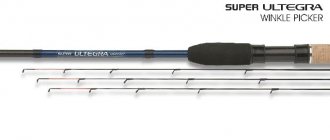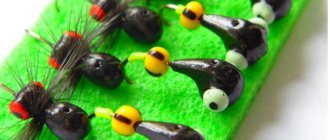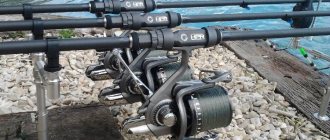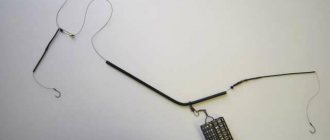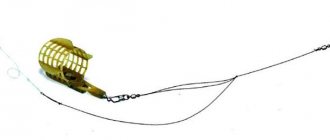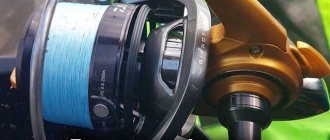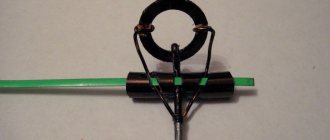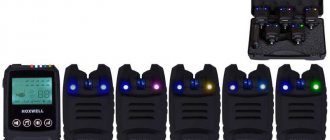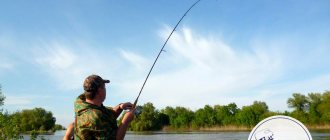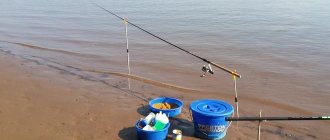Picker equipment
With a top picker test of 50 grams, you can use light feeder feeders weighing 10-20 grams. There is an opinion that with a sinker weighing up to 20 grams, both asymmetrical and symmetrical rigs reduce the sensitivity of the rig.
Most likely this happens because they are knitted from thick fishing line to make a twist, and a light sinker sometimes makes it difficult to tension them, which reduces the sensitivity of the equipment. We also do not recommend using an anti-twist tube on a picker, as it greatly affects the range and accuracy of casting light weights. It is advisable to consider light picker rigs - the same “blind” and “sliding” rigs.
Bait for pickerel
There is an opinion that the use of feeders for pickerel fishing is the exception rather than the rule, and this imposes special features on picker bait. The bait is made thicker than the feeder bait mixture, and you need to make sure that the bait ball does not break when it hits the water.
In order for a strong current to wash out less food when sinking to the bottom, you need to speed up the immersion of the balls. And to do this, it is necessary to make the bait heavier by adding clay to it, weighing 30% -50% of the volume of the bait. We do not recommend using earth or sand, as they do not have the same viscosity as clay.
Let's summarize all the above information. So, a picker, unlike a feeder, has a shorter length, weight and test, which makes it a very delicate tackle, and allows you to fish with it only at a short distance from the shore, unlike a powerful feeder.
Read many useful articles about feeder fishing in our section here.
Picker or light feeder?
For many anglers, the word “picker” does not mean anything, while others, on the contrary, emphasize picker fishing. In this note I will briefly talk about my view on this topic.
For me, a picker is the same feeder, only shorter and more “gentle.” In use, in installations, and in fishing itself, it performs the same functions as “adult” feeders. There is no official classification of them; many manufacturers do not distinguish them separately, they simply write a light feeder. But if we single it out, then rods up to 3 meters in length, inclusive, with a weight of up to 40 grams can be considered picker rods.
Pickerel fishing is used on small rivers, streams, ponds and overgrown lakes. The rods can be very short - only 2.4 m, but with them there are more disadvantages than advantages in fishing. Therefore, the most popular rods are 2.7-3 meters long. They are convenient for fishing at distances of up to 25-30 meters. Often fishing occurs “at the feet” - 5-10 meters from the shore. As a rule, picker rods are equipped with the softest signal tips: 0.5, 0.75 and 1oz (ounces). This configuration makes them ultra-sensitive for close-range fishing. But this does not mean that the picker is a frivolous tackle! With a picker they often catch small and medium-sized carp, weighing up to 3-4 kg, crucian carp, tench, roach and all other fish to which they can throw the bait.
Since these rods are not long, they need to be equipped with medium-sized reels. Firstly, this does not make the tackle heavy, and secondly, when casting with light feeders at 20-30 meters, you don’t need any powerful reel, and they will cope perfectly with medium-sized fish.
In picker fishing, as well as in feeder fishing, the question is whether to use an open cord or line. But, most anglers are inclined to use fishing line, since the fishing distance is short, bites are clearly visible, and the fishing line absorbs jerks of the fish and our hooking. The cord is most often used by sports anglers when they need to catch very capricious fish at close range, when every gram counts, when it is important to “see” even how the fish “breathes” on the bait.
In picker fishing, the same rigs are used as in the feeder; there are no separate requirements for them or the equipment of the rods. In picker fishing, they pay more attention to the characteristics of reservoirs: where is the bottom, what kind of vegetation is on it and the behavior of the fish...
The advantages of a picker are the lightness and compactness of the gear, maximum sensitivity and the ability to fish under trees. Thanks to the action and test of the rod, when fishing, the fish walks along the water all the way to the shore, which helps reduce the number of trips.
The disadvantages of a picker are that it is more difficult, and often impossible, to lift the tackle above the edge; casting is difficult when fishing on a bank overgrown with grass. I don’t single out pickers for myself - I have all feeders. Rods up to 3.3 meters long and with a weight of up to 50 grams are considered lightweight and these are my favorite rods in bottom fishing. It is precisely these rods that give the maximum bouquet of emotions when catching strong and lively fish! I would call light feeder fishing fishing for feeder gourmets. This is fishing on paid reservoirs with light rods for carp, crucian carp and trout. In summer, in small and medium-sized rivers, when the current allows, all the fish. In a word, wherever conditions allow fishing with these rods, I fish with the lightest ones. The Salmo Group product range includes several fishing rods that belong to the group of picker rods.
The Elite Picker 40 is an amazing rod with the best value for money. If you are wondering whether or not you need a picker rod, look for something that is not too expensive, but of high quality and almost eternal, then Elite is exactly what you need. Team Salmo Energy Picker 40 is the first luxury rod: lightweight, semi-parabolic action, successfully used in both amateur and sports fishing, excellent for fishing on platform sites.
Determining principles for choosing a picker rod
The choice of picker must be carried out in accordance with its purpose, taking into account, if possible, the characteristics of the reservoirs you most frequently visit. It should also be remembered that all picker rods have a main section and a replaceable tip . The vertices are divided according to the degree of sensitivity:
- Soft tips are designed for reservoirs without current and when fishing in calm weather;
- with medium tips when fishing in a body of water with a small current;
- Hard tips will be needed for fishing in a reservoir with a stronger current and in windy weather.
Also, pickers, like any other fishing rods, are divided into classes depending on their test values:
- Light picker has a maximum dough value of 40 grams. Designed for catching the most cautious representatives of the fishing kingdom in small bodies of water without a current.
- An average picker rod allows you to work with weights from 40 to 80 grams. This is the most universal representative of this type of form.
- A heavy picker has an upper test value of up to 120 grams and is designed for long casts and fishing in currents.
The most universal picker , suitable for almost all fishing conditions using this method, is considered to be a rod with a length of 2.1 to 2.7 m , made of graphite or composite material , equipped with a tip of medium hardness and having a test weight of up to 60 grams . The coil used, as a rule, is a regular one - inertia-free.
For beginners, it is better to choose a picker from inexpensive specimens made of fiberglass, up to 3 meters long with a medium tip. As each angler gains experience, he begins to give preference to different variations of this form, completing it at his own discretion and to his taste. Some fishermen prefer to make a picker from a spinning rod, adding one or two guide rings to it to more evenly distribute the load on the rod that occurs during fishing and equipping it with the desired tip.
klevyj.com
Advantages of a picker compared to a feeder:
- Lighter and smaller equipment is much easier to handle. The fisherman can make quality casts in places where there are coastal trees. The use of a long feeder in such areas very often becomes impossible. At the same time, the power of the picker is much less and it will not be possible to compete with particularly large specimens.
- A lightweight lead sinker makes an almost imperceptible sound, which scares the fish much less than in the case of a heavy feeder. But this disadvantage of feeder gear is compensated by the fact that fishing with their use is carried out at great depths, where the fish may simply not hear this sound due to the great distance.
- You can feed them in two ways - using a feeder weight or manually.
- The cost of a picker is much less than a feeder.
The main disadvantages of picker:
- Fishing in bad weather with strong winds is difficult, as the fishing line loses tension. In this case, bites will not be transmitted correctly to the rod. But if we compare the picker and float fishing methods, then the second one is much inferior, especially in the autumn. For example, if we consider the bite of crucian carp on a float and pickerel, autumn makes its own adjustments in the form of a wind-driven wave. In such conditions, tracking a bite on a float is very difficult, and sometimes even impossible.
- Equipment suitable for pickerel is not used for fishing at long distances from the shore. Not everyone can catch a big fish, but professionals can argue with this, since many people have been able to catch small carp on a pickerel.
Tackle layout
The length of the picker rods used varies from 2.1 m to 3 m, weight – about 100 grams, test – up to 50 grams.
Almost any reel for picker is suitable, but you need to correctly determine its size. For beginners, it is recommended not to take risks with the choice and take a reel with size 3000 from a good manufacturer. In the future, with the accumulation of experience, the fisherman will be able to easily select reels and install more effective gear.
As the main fishing line, it would be most suitable to use monofilament with a diameter of 0.14 mm to 0.2 mm. Its advantage is its stretchability, which has a positive effect on fishing when a powerful specimen is hooked.
The leashes are made from fishing line with a diameter of 0.12–0.14 mm. You definitely need to pay attention to the quality of the thread and purchase only those products that have good reviews. The length of the leashes is selected depending on the bite. If the fish is active, then a short leash is suitable; if not, a long leash is tied.
Picker feeders are selected depending on the fishing conditions. If you plan to hunt bottom fish, use those devices that can deliver food to the bottom of the reservoir. To catch species that spend most of their time in the upper or middle layers of the water column, you need to use feeders that release bait immediately after casting.
Picker area of application
Picker is mainly used in reservoirs with standing water. If there is a current, it should be small or, at least, medium. Casts are made over short or medium distances. Very rarely the fishing range reaches 30 meters. Fishing for crucian carp with pickerel, as well as roach, rudd, bleak, silver bream, and small bream is carried out most often. With the right equipment and extensive experience, you can catch a fairly large specimen.
Picker is effective on ponds, lakes, bays, small canals and small rivers. This tool also allows you to make high-quality casts in places where a long feeder rod simply does not fit, not to mention the fisherman.
Thanks to the flexibility of the blank, the fisherman can make accurate and accurate casts over short distances, and since in lakes and ponds fish tend to accumulate close to the shore, this distance is quite enough. In such cases, fishing using this gear gives excellent results that cannot be surpassed by any other fishing method. Also, due to the same flexibility, the number of fish coming off the hook is minimized.
Picker vs feeder
Nikolay Linnik
The question of which variety of English donkey - picker or feeder - is the more effective tackle for catching large river fish arose in my mind about 10 years ago, when I first watched a videotape where a brave fisherman, sitting in a chair, enthusiastically dragged rivers of white bream and palm-sized white bream. He accompanied his actions with a commentary in which the foreign words “picker” and “feeder” popped up every now and then. Now, with the passage of time, I can confidently say that the graceful pickerel very often surpasses its “big brother” in terms of efficiency in catching large fish in the current.
For those who don't know, a pickerel is a type of English bottom fishing rod. Most fishermen indiscriminately call this gear a feeder. It is generally accepted (no one can say for sure who came up with it and when) that it is most effective to use donka when fishing channel edges remote from the shore. And therefore, the main advantages of a rod for bottom fishing are its length and power (test). But for a light pickerel, the maximum test of which does not exceed 40 grams, and the length of 3 meters, no one can think of a better use than catching small fish in the coastal zone. Therefore, among adherents of bottom fishing, the number of feederists is tens of times greater than the number of pickerists.
To be honest, just a few years ago I myself believed that the feeder would always be in the lead in terms of performance, and I privately called the pike players “runners.” “Settled” feeders, who fed and caught one, maximum two places throughout the day, occupied a higher level in my classification. Until one day I had to verify the effectiveness of the picker by my own example.
Mid-October is not the best time for fishing on the river, any angler will confirm this, but I didn’t want to end the open water season, and the remaining porridge in the refrigerator had to be used up by the beginning of winter. In general, I found myself on the river bank at the wrong time. Moreover, the section of the river where I was taken was completely uninteresting in terms of bottom fishing. A long stretch, with a maximum depth of 2 meters - here even in the summer you can only count on a bite from the ubiquitous white-eye.
A gusty north-west wind, driving low clouds over the leaden water of the river, from which light rain fell every now and then, very quickly cooled my initial ardor. At first, as befits a feeder, I tried to attract fish to me with bait. But he very quickly abandoned this idea. Each cast of heavy tackle at a distance of 30 meters brought an indistinct bite, which was very difficult to respond to. And if this was successful, a small silver bream dangled on the hook as a consolation prize. It was necessary to change the place.
But doing this while dragging heavy feeder equipment was not so easy. Having changed 4 places over the course of three hours, I eventually came across a small pool located near a willow bush washed away by water. The autumn day is short, and I understood that this was my last chance to meet a large fish, but due to the thickets on the shore it was impossible to use a long feeder. And there was no time to feed the place. It was necessary to radically change tactics.
And now, out of the case with the rods, the picker is taken out into the light, which I have been dragging around with me for several months just like that, just in case. Installation of the equipment took a few minutes. Since the river flow in this place went somewhat to the side, and a small “return” was formed near the shore, it seemed to me not entirely correct to use a rigid installation of the feeder. And so I used an asymmetrical loop.
This type of equipment installation allows the feeder to move freely along the line. When biting, the fish notices the catch much later, which is very important when you have to fish short distances. When I fish in the current, I like to use long, half a meter, leashes. The fish, it seems to me, are afraid of the feeder, and fishing for a large trophy on a long leash is much more convenient: there are practically no fish gatherings. And, of course, a swivel is tied between the main line and the leash.
Choosing the “right” hook for bottom tackle is a very important moment. Traditionally, most anglers continue to equip their donkeys with powerful hooks that must withstand the jerks of large fish. Maybe for their powerful “sticks” this is the best option, but for an elegant pickerel, especially when maggots or bloodworms are used as bait, such hooks do not “roll” at all.
The fact is that in most cases the angler notices a fish bite on rough bottom tackle only after the fish, having been pricked on the hook, begins to fight. The picker allows you to notice the slightest touch of the fish on the bait, and a sharp hook is an additional guarantee that the fish will notice the catch much later. This means that it is easier for the fisherman to react by hooking.
For several years now, my favorite “bottom” hooks have been hooks under the KAMASAN and OWNER trademarks. Expensive KAMASANs, in my opinion, are generally the No. 1 hook for donkey, and when I have to fish in an unfamiliar place, I use OWNER. Possessing high quality, OWNERS are cheaper.
Differences between feeder and picker, their advantages and disadvantages
What are the fundamental differences between a feeder and a picker?
Feeder and picker are the so-called English tackle (or English fishing rods). The basis of both types of fishing is the use of a weight and a hook with bait on a leash. The equipment is thrown into the designated fishing spot, often at a sufficient distance from the shore, the line is stretched and the angler begins to expect a bite on the tip of his rod. The rod is installed on a special stand, everything is very simple and accessible.
Under what conditions is it fished with pickerel?
When fishing with pickerel, feeders are not always used - many people feed the fish with slingshots or balls. However, there are a lot of casts and the impact of the bait on the water can scare away the fish. Therefore, some people prefer a weight that helps the baited hook reach the desired area.
The picker tackle is not cast far - within 40 meters. The picker is not intended for catching trophy specimens, but if you catch one, you can be confident in the reliability of the rod.
To summarize, a picker is a short fishing rod for catching small fish at close range in small rivers (lakes). The advantages of such equipment are especially obvious when there is a strong current or in overgrown places - where other equipment is useless.
Differences between feeder and picker
Feeder gear involves the use of a feeder weight (a piece of equipment that is filled with bait before casting, and after casting, the food is washed out at the bottom and begins to attract white fish).
The difference between a picker and a feeder is that it uses not a feeder weight, but an ordinary lead sinker. Often, such equipment has less weight and is aimed at catching smaller fish than on a feeder, and you can feed by throwing food manually, or using handy means (for example, a slingshot).
Advantages and disadvantages of picker
Advantages
- A light sinker scares the fish much less and bites follow much faster and more confidently, even when fishing at shallow depths.
- Handling light equipment is much easier than physically handling heavy equipment (you don’t have to quickly reel in the reel and constantly hold the rod tip to the top so that the heavy feeder load does not get caught on a snag-covered or rocky bottom).
- Feeding must be done using separate means , or first feeding using a feeding weight, and then connecting a replaceable sinker. Although using a light feeder weight is also acceptable, it will not be as effective.
Flaws
- Rarely usable in bad weather. In a strong wind, the tension of the fishing line from the tip of the rod to the picker equipment will weaken greatly, you will not be able to fish in the designated place, and you will not be able to get clear bites on the rod.
- It is less suitable for fishing at a great distance from the shore , as well as for catching large fish due to the equipment being too light.
The main distinguishing features of a picker from a feeder rod
So what is a picker rod? At its core, this is an ordinary feeder , only in a shortened and very lightweight version . This is a light tackle for catching bottom fish, equipped with either a light feeder sinker, or simply a lead sinker of the required weight and a retractable leash with a hook. It is usually used when fishing in small ponds and rivers with weak currents.
It is much easier for it to reach a certain place on a reservoir when casting gear, but the casting distance will not be as great as when casting with a feeder, and is usually limited to 20 - 25 meters . Such a stick must be equipped with a flexible tip, which allows you to notice any bite, even a weak one, in time.
Many experienced feeders, when asked what a picker rod is, answer that it is an ordinary ultralight feeder up to 3 meters long . They are partly right, if you do not take into account the fact that a picker rod consists of two legs, and a feeder rod – of 3, and sometimes more.
Feeder advantages
- The feeder, unlike the picker, is excellent for fishing in bad weather and works great at a great distance from the shore when catching large fish.
- Fishing with a feeder usually takes place at great depths, so strong splashes during casting can be considered not frightening or slightly frightening to bottom fish.
Paternoster rigging - how to correctly tie one of the simplest riggings for a feeder.
And here is a link on how to equip a feeder rod. How to prepare good bait for carp - several proven recipes.
Feeder fishing techniques and tactics
Feeder fishing provides the opportunity, using only one feeder, to feed a certain area of the reservoir with precise periodic casts, and to fish far from the shore in a baited area.
Feel even a very weak bite, and, as a result, get much larger catches in comparison with other bottom gear.
In order to cast exactly to the same point, you need to clip the fishing line into the reel clip. At the same time, the vertical position of the rod during the fall of the feeder and the shock leader soften the jerk. These rods are distinguished not only by their length, but also by their test, i.e. as intended.
What is the difference between a feeder and a picker?
- Go to page:
What is the difference between a feeder and a picker?
Post by Eduard Ball » April 10, 2012, 09:48
Re: What is the difference between a feeder and a picker?
Post by Karpukhin » April 10, 2012, 11:07
Re: What is the difference between a feeder and a picker?
Post by valentin » April 10, 2012, 11:26 am
Re: What is the difference between a feeder and a picker?
Post by Romanych » April 10, 2012, 11:30
Re: What is the difference between a feeder and a picker?
Post by Donk » April 10, 2012, 12:19 pm
Ultra Light Feeder (Picker)
This name is rarely used. Rods of this class have their own name - “Picker”.
These are rods with a length of 2.1 to 3 meters, characterized by a small test: from 10 to 40 grams. Ideal for catching small fish at short distances in still water or with little current. The distances for them are also different: if for a picker with a length of 2.1 m the optimal distance is up to 20 meters, then with a 3-meter picker you can fish without problems at a distance of 40 meters. Typically, pickers are equipped with monofilament fishing line.
Re: What is the difference between a feeder and a picker?
Post by Eduard Ball » April 11, 2012, 11:13 am
Re: What is the difference between a feeder and a picker?
Post by valentin » Apr 11, 2012, 9:16 pm
Re: What is the difference between a feeder and a picker?
Post by Donk » April 12, 2012, 2:58 pm
Re: What is the difference between a feeder and a picker?
Post by Kochevnik.73 » April 14, 2012, 6:21 pm
Re: What is the difference between a feeder and a picker?
Posted by Sony1976 » April 15, 2012, 2:29 pm
Telescopic tackle in feeder fishing is a manifestation of bad form. In my concept, the feeder and picker are only plug-in connections. And I have never seen a pickerel up to 2 meters long. Somewhere on the forums I came across information about pickers up to three meters long, but with a dough of more than 60 grams. This was motivated by fishing at close distances in rivers with strong currents.[/quote]
I think that a fidr or picker telescope is quite sporty and normal. After all, everything is according to science - 1 hook, feeder. What is bad tone? In some parameters, the telescope is even preferable and universal.
Re: What is the difference between a feeder and a picker?
Post by zloyArtist » April 16, 2012, 07:39
40m of fishing area means slight current or stagnant water, as for a plug or TV, that’s absurd. Both things happen. But with monofilament equipment, etc., I’m not sure that this is the correct definition.
Re: What is the difference between a feeder and a picker?
Post by Eduard Ball » April 21, 2012, 10:40 pm
Re: What is the difference between a feeder and a picker?
Post by Eduard Ball » April 21, 2012, 10:52 pm
Re: What is the difference between a feeder and a picker?
Post by Aleksei1982 » Apr 23, 2012, 10:07 am
I rarely fish with a float, but when I do catch it, I feel irritated by the telescope... I agree with those who wrote above, the difference between the telescope and the components is colossal..
I have a 3.6m feeder up to 80g, a picker 2.70 up to 40g. Pier catches more actively and more, the feeder is larger and of better quality. I always fish with both poles.
The main advantages of a picker over a feeder fishing rod
Since such rods exist, it means they are needed for something and are somehow superior to their older relatives. The main advantages when fishing with a pickerel rod are:
- Using this lighter, shorter tackle makes it much easier to make accurate casts on tree-covered shoreline areas. The likelihood of an annoying snag in this case is much lower.
- A much lighter and smaller sinker makes an almost inaudible noise when casting the tackle. This is a very useful quality for any fishing, and especially when fishing for cautious fish at shallow depths.
- Possibility of feeding fish in two ways: using a feeder weight, or manually. Due to the fact that the tackle is thrown over short distances, bait can be thrown there manually or using special slingshots. In this case, the picker tackle is equipped with a conventional sinker (often an “olive” or “ball”) and is delivered to the fishing site with minimal noise, but with maximum accuracy.
- Convenient when fishing from a boat.
- The price of such a picker blank is less than a feeder rod.
It is also worth noting that the process of fishing and managing the tackle, thanks to the light weight and size of the picker, is easier and more enjoyable.
